[Review] Night Wolf Inn (AD&D 3PP); Promised Land
[Campaign Setting]
Night Wolf Inn (2016)
Anthony Huso
AD&D 1e
Lvl 1 – 15
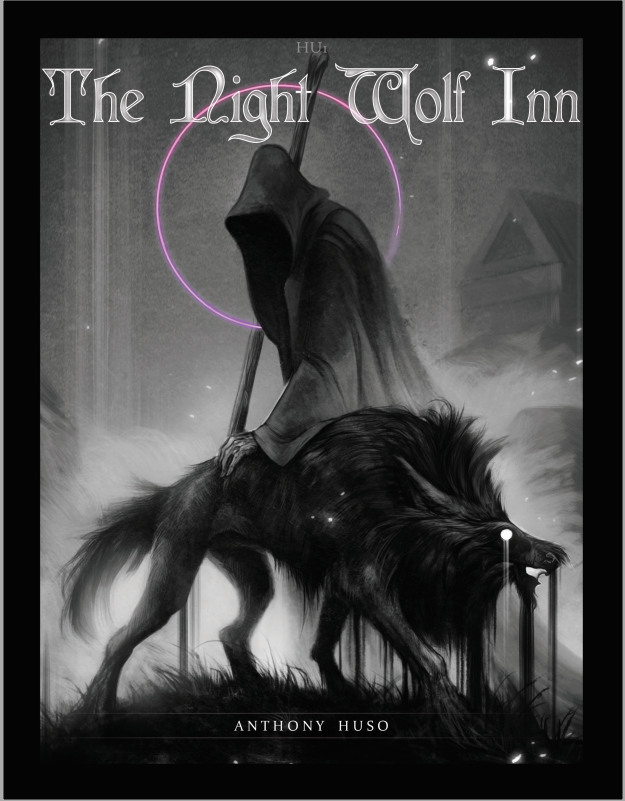
I started reading this because I was looking for good high level material and Anthony Huso wrote Dream-House of the Nether Prince, arguably the best high level adventure ever made, and certainly the best one I ever played. About 40 pages into the 189 page PDF I went online and ordered a hardcopy. Reading too much Artpunk and OSE adventures for level 1 to 2 brings with it a deep malaise, a blanket on the soul. But every once in a while you come across a pure gem, the distilled efforts of years and even decades of campaigning by a man with a deep and obsessive understanding of both gamedesign and AD&D 1e, a game already notorious for demanding greater investment then almost any other game, and you think, perhaps those fertilizer bombs can wait for another day. You could argue with all the colorful descriptions and the boxed text and the ornamentation like the subtle transition from black text on white paper to white text on black paper when you reach THE DARK PASSAGE that this is Artpunk but you would be wrong.
Let me show you the ways.
The concept of the Night Wolf Inn is that it exists on many planes, each room leads to another place, and threaded throughout the place are secret doors, riddles, secrets, mysteries and dangers, all tied together by an overarching mystery that the players might never see. 18 Guest suites, each leading to a unique plane dotted with both creatures culled from 3 monster manuals, a host of Dragon magazine articles and the manual of the planes and a light dusting of unique creatures. Add to this the various nooks, crannies, catacombs and extraplanar areas that exist under, within and between the Inn and you have yourself a delight, and intricate puzzlebox for the players to unravel at their own pace.
Night Wolf Inn is a love letter to AD&D 1e and the Manual of the Planes, sprinkled with some 2e-isms that are more redeeming then damning, a compelling mystery that you place somewhere in your campaign world and that the players can explore pretty much on their own terms, choosing their own level of engagement. It is explicitly created as something that can be placed in a campaign world and visited at the PCs leisure, alongside business as usual. Indeed, it is in many ways a redeemer for the sins of Planescape, an eminently playable tonic against the disease of meta-plot wankery and coffee-table mummery.
This is not a casual thing that can be kicked off within 2 hours of purchase and will require careful study and preparation so the GM may become familiar with its contents. Taking into account the uncompromising choice of system and the virtual neccessity of using several sourcebooks, the cause of its relative obscurity when compared to other vastly inferior works becomes more apparent. This is a high-investment book for people that do not shy away from a random encounter table with references to Jun 1983 Dragon mag articles or liberal use of the Psionics rules. I mean there’s a reference to DUNGEONEER SURVIVAL GUIDE for gygaxssake.
The Inn itself: numerous special effects are present, from a restricted spell list (which is fairly easy to remember), to a chance of glimmer doors appearing that if entered will propel the character and any comers into certain areas of the Inn so as to facilitate exploration. You notice as you read into it that Huso, who has a background in gamedesign and is well known in the Thief- community, knows when to push buttons and knows when to exact a price. He is liberal with his rewards but you get a great sense of checks- and balances. The guest-rooms, which allow entry into various demi-planes, each have a very high cost per night (from 50 gp to 350 gp per night, but then very often the guest rooms will have some item in them that the PCs can borrow, only for it to return to its original location in 24 hours. There is even an enchanted Ballroom that can be rented for 1000 gp, allowing the PCs to conjure illusionary versions of anything they have seen or heard from to try themselves out in battle, which grants about 15% of the combat XP and provides no treasure.
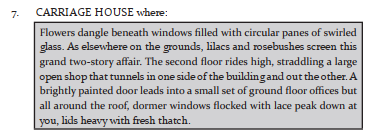
Room descriptions are lengthy but not bloated, and make use of an intriguing division. Purple Prose Boxed text consigns all the atmospheric description to a specific location and then fucks off into clear, descriptive text, using lists and bullet points where appropriate further divided into The Obvious which is information that is immediately apparent, and the Not So Obvious which is information that is only revealed after closer examination (or worse!). The playful anachronism of a victorian fantasy inn run by a charismatic butler named Jeeves is offset by a sense of tangible menace to some of the encounters. Magic, rich reward or horrible danger is at times only a few steps away, or subtly hidden in a way that rewards closer scrutiny. The inn is deadly as well as enticing. There are fountains filled with undead koi pond, towers of steps that turn to serpents, hidden hatches that must be researched and open only on a certain time of the month and far, far worse. A pure hack and slash party might enjoy some forays into the planes to fight various outer planar horrors and certainly the Dungeons in the Cellars would be enticing but those who enjoy riddles, subtle hints, deadly puzzles, hidden meanings that hint at a greater signficance and most importantly EXPLORATION, are likely to gain the greatest enjoyment from this non-euclidean puzzle maze. The light touch of modern game design is present but not intrusive, as Huso has an excellent grasp for the type of stimuli that are likely to lead players to explore further, often using it to great effect, sometimes using it cruelly to ensnare and trap in a way that is absolutely brutal.

Do you go in?
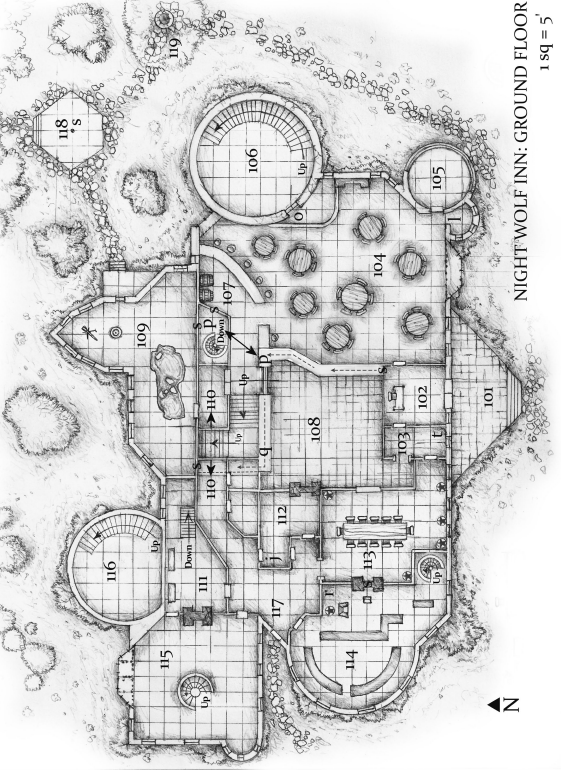
Beyond the immediate guest rooms and habitable places there are crawlways, cellars, belfreys and attics. Here the Inn becomes properly deadly. The spatially deranged nature of the place is taken full advantage off through non-euclidean geometry, temporal distortion, spatial trickery and the appearence of concealed doors. Huso is not afraid to utilize some of the more dreadful entries in all of three monster manuals and employs to cruel effect, among others, Thought Eaters, Shadow Dragons, Beholders, Ghosts, Mind Flayers, Disenchanters, Apparitions, Rakshasas, and a host of other deadly creatures, some of which his own tasteful creations. You fight a dungeon master who knows full well the awesome power contained within those three tomes, and you forget this at your own peril.
The CELLAR is perhaps closest to a regular dungeon but even this is an intricate maze, entered through one of a dozen ways, connected to the Inn in one other. There are, scattered throughout it lightly, some doorways to other planes, another dimension and why the fuck not, the Underdark or for that matter, a Necropolis of some buried Giant Kingdom. These are left as seeds for the GM to develop, something that is impossible to avoid when dealing with alternate realities, planes, deeper layers and so on, but Huso gives you enough to work with (more on this later). All of this is given room to breathe, and interspersed with wholesome and very deadly dungeon crawling. I think I noted somewhere that the better and fairer you were at GMing and adventure creation, the deadlier you could afford to be. Huso is pretty good and fair from what I can tell, so get ready for some very nasty punches. Ageing, statt loss, item destruction, level drain, these are all employed, tastefully and with restraint.

Notice the mature mapping technique, use of elevation, inclusion of natural hazards like water. Encounters are weighted towards something more in line with late (WotC era) 2e or even S4 then hordes of simple but well-organized antagonists with orders of battle. That means relatively low numbers of deadly antagonists with complex arrays of abilities. This is interspersed with intriguing weirdness (say, a shimmering curtain of fog that has a chance to duplicate anyone walking into it along with his items but it might also cause instant death), areas that lead to another plane but can only be accessed via a secret concealed elsewhere in the inn, strange altars surrounded by a pool of regenerating Black Pudding and Puzzles. A handful of new monsters, each with tasteful and deadly abilities, is added as seasoning, providing a unique threat where it is warranted to keep the players guessing. But if the full range (including the dragon articles) is utilized, even the most jaded player in the game is likely to come up against multiple threats he has never heard of.
Puzzles don’t have to suck but they very often do. I have seen people throw up at the sight of yet another chessboard floor. Using some synergistic power of video game design, years of GMing and what I assume is at least 3% Atlantean DNA, Huso manages to make them more or less not suck. Part of it comes from Night Wolf Inn always providing about 50 different other possible avenues of exploration, part of it is subtlety. In case of Huso, some of the puzzles will trap you and you either solve them or you die.
There is a way to do these things that is quite subtle because they obviously cannot be too hard so that a reasonably intelligent player cannot solve them with enough persistence but if they are too easy the GM faces ridicule and possible bombardement with faeces (in the case of BECMI players). Take say, the room of air that holds the (very hard to find) Four Winds Bar. You are in the room, besides some skeletons and the bar it is more or less featureless besides a fresco on the floor of air and clouds. It is called the Four Winds Bar, this is written on it. If you touch it to a corner you hear a chime. The skeletons signal the price of waiting. How do you proceed? I am wary but they work at this level. In other cases he allows brute force or multiple solutions. And then there is the semi-random teleportation maze that ages you several months each time you try. Brutal.
Treasure is lavish, hard to estimate because of the wide level range but you get the feeling Huso is an easy come easy go type of guy. Large rewards are followed up with brutal punches. Ability scores can be gained and lost. A stray detail, easily missed, can reveal a tremendous reward or save you from a horrible fate. Even though Night Wolf Inn must have three billion unique items in it this is never noticed because all of it is more or less seamlessly integrated with the existing library of magic items and treasure. It all feels like an extension, with well considered additions meant to enrich an already welcome experience.
In some cases, exploring the Inn can put PCs out of comission for weeks or in some cases years and Huso makes it clear it is expected that each Player will likely have more then one character and considering some of the threats that are to be found in the Inn, this is likely to be as much neccessity as it is luxury.
The main draw of the inn is not even this intricate death maze but the suites and rooms, each leading to a seperate demi-plane. It feels like an extension, and welcome elaboration of an alternate Planes, never shit up by Monte Cook. A forest of dreams, a dowsing web of Phase Spiders, a high-gravity cavern inhabited by lizard races, offering up human sacrifices to Mind flayers wielding futuristic space technology. A dimension of Piracy, black powder weapons and high adventure. All of this and more awaits, some very rich and providing a hint to the overlapping mystery of the Inn, some of it conceals a deadly trap, some of it is merely inert. There is even, and I dare say it not, a room that leads into a dimension of blank hex paper. Often times the rooms have magic items in them that will return to their starting locations after 24 hours, providing further incentive to try out the various rooms.
There is a way to do these types of things and Huso explains his rationale. The idea is that you don’t know what suite the PCs are going to pick in advance. Therefore you get the prevailing conditions on the plane, a list/random encounter table of its inhabitants (here the Dragon magazine articles might trip people up), and either a minor location (equivalent to a lair), or a series of bullet points with adventure seeds, encounters and ideas. The idea is that you have enough material to run about a session’s worth out of your ass and then have time to further expand the area if the PCs consider it exciting. Occasional forays into blackpowder or even high technology might be shocking to genre purists, but in 1e land, this is delightful and certainly not beyond the pale.
There is so much material here that any description will only scratch the surface. It would already be great. But buried in this well of nested infinities and areas is a greater mystery, a trail of breadcrumbs that is merely hinted at. According to Huso it has not even been ‘solved.’ Wankery you think. In most other cases, absolutely. Here, like an actual game designer, so many encounters and areas point to these elements and features. Huso even offers ‘membership’ of the Inn at a high fee, which gives the PCs a discount, a magical tattoo that gives you +1 AC, and an obligation to perform tasks for the mysterious Master of the Inn. At first these tasks will seem significant but are actually innocuous, later they will seem cryptic, but they place the PCs in areas where they are likely to interact or come across one of the puzzle pieces to the central mystery. And then you can, if you reach a certain level and have been at the inn for multiple years (PACING! PACING!) gain a new rank and a stronger mark, which will in turn place you under a greater obligation. It all rewards greater investment but it is always just light-handed enough.
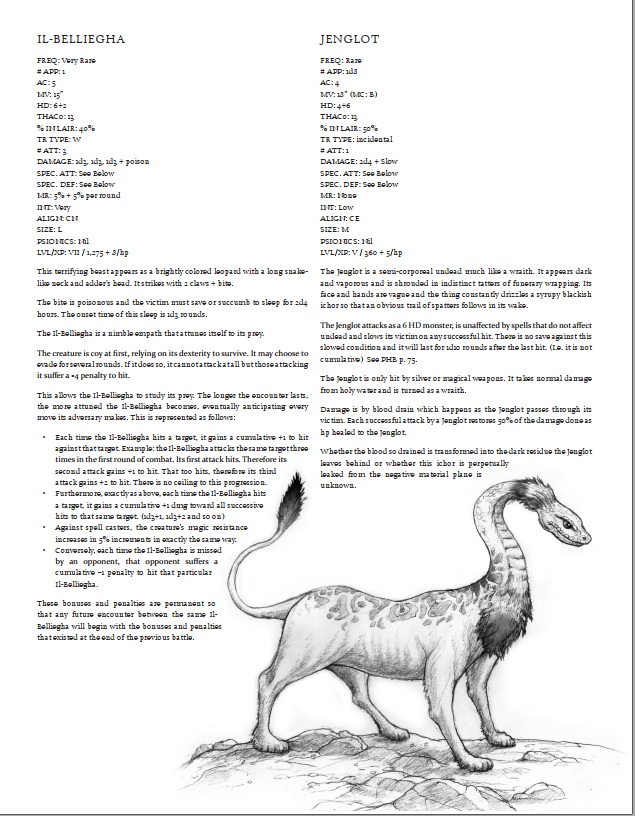
Unlike many another review, I will not spoil the central mystery. Several of the initial steps take place within the fully actualized and gameable environs of the Inn. Some of it takes place on the Planes and requires the GM get his GM hands properly dirty, which is also great to see. Nightwolf Inn does not feel like something that is made for a lazy consoomer, desperate to fill the hole in his life with yet another chunk of gameable, unchallenging material. Instead you are given something that will require some investment on your part but that gives you seeds and ideas to inspire you. The task feels properly herculean, but is not made artifically difficult by the massive employment of high level monsters. Perhaps appropriately, it is more about piecing together what is going on, figuring out how to counteract it, possibly dying or losing a few characters in the attempt if you are incautious, and finally putting it all together. The amount of convolution is kept to a tasteful amount, about 1/3 Cordell, and the lack of universe-shattering threats are appreciated.
There are a few points to remark on. Though the inn comes equipped with a giant list of 100 readymade NPCs to be used as rivals, retainers or enemies which is FANTASTIC, the major NPCs are described in long, flowery passages that might be a bit much for some oldschoolers. Here too we perhaps detect a spectre of 2e.While some of the characters like the Butler (duelist class) Jeeves might come off as charming, there is a worrying veering off into drama-club land and I did have to raise my brow a bit at the detailed procedures (and primary requisite ability score enhancements) for getting in a relationship with the sexy moon-elf bard character that, yes virginia, has hair that changes color with her moods (surprise is Pastel Pink!). While this is not Medusa BBG with primary motivation to have gay sex levels of cringe, it is still cringe.
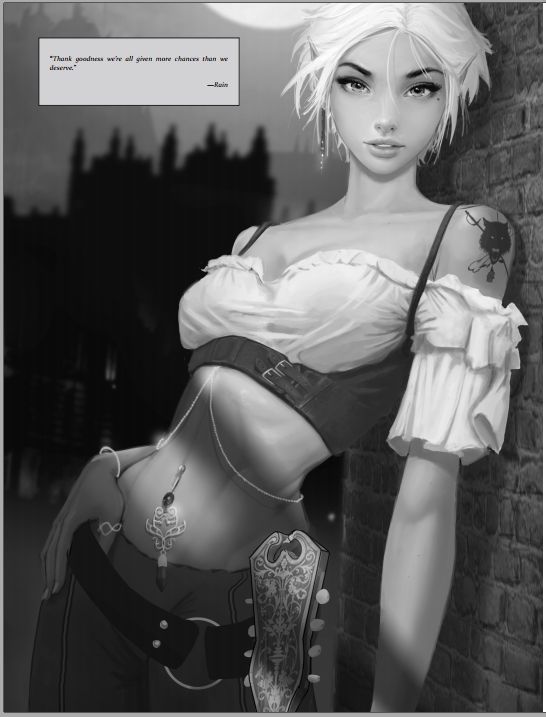
Questionable stylistic eccentricities and occasional thick canisters of purple prose aside, Night Wolf Inn is the product of a deep understanding of and commitment to AD&D, honed over years of play, gorgeously produced, imparts its own vision onto a proud tradition, is made to be dropped inside and used alongside one’s own campaign, presents an intriguing opportunity to introduce planar adventuring to unsuspecting parties in a way that is compatible with the hierarchy of the original game and leaves the mystery mostly intact, has a host of fine Gygaxian building blocks to delight in and die to, does planar adventuring correct (haters shall quibble), does puzzles correct, does regular adventuring correct, understands MYSTERY and that the way to introduce something like this is one of GRADUAL UNFOLDING and recursion and is overal one of the most intricate, complex, detailed and advanced things that I have ever seen in my almost decade long torturous hellish existence as a reviewer of our Dead but Eternally Reborn OSR. When the last of us are turned into soylent green doritos for the Alphas to enjoy during their 2 hour games of Shadowdark 6e, we may be pulped and mashed contentedly, looking back at the few great things that it has produced. This is no product for the uninitiated and the normie, but should prove delightful to intermediate and even veteran GMs, even if the flavor leans more into late 2e then gygaxian 1e.
TLDR: Night Wolf Inn is so impressive that it makes me want to rate other things lower. My vision in the desert of an OSR that existed as a wholesome continuation of Old school gaming continues to prove itself correct.
*****
Get No Artpunk II
No Artpunk II
The best collection of oldschool material
| Status | Released |
| Category | Physical game |
| Author | PrinceofNothing |
| Genre | Adventure, Role Playing |
| Tags | artpunk, nsr, OSR |
More posts
- NAP III Winners announced - PDF coming soon!Mar 27, 2024
- [No-Artpunk] Review of #16 Slyth Hive (AD&D 1e)Feb 03, 2024
- High level review: Halls of Lidless ShabbathOct 10, 2023
- A special thanks to all who donatedSep 09, 2023
- Nap III: Slyth Hive PlaytestJul 18, 2023
- [HYPE] Announcing No-Artpunk IIIMay 28, 2023
- Official NAP Tournament Reference BibleMar 18, 2023
- Review of H4 Throne of Bloodstone (lvl 18-100)Mar 12, 2023
Leave a comment
Log in with itch.io to leave a comment.